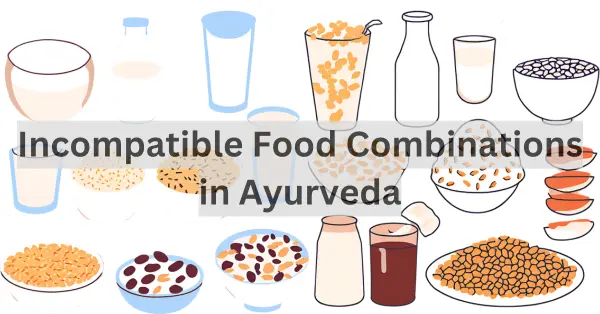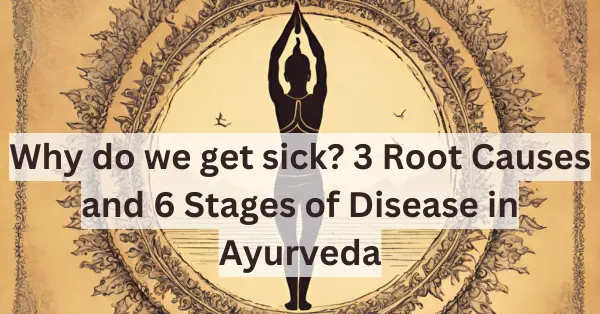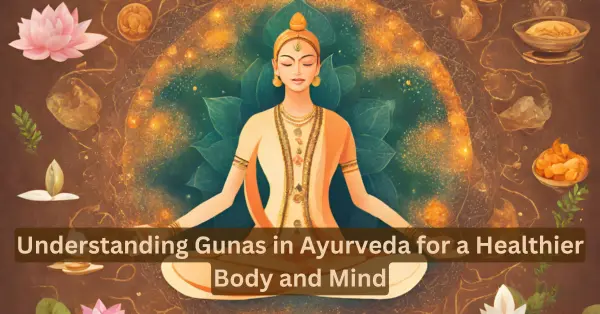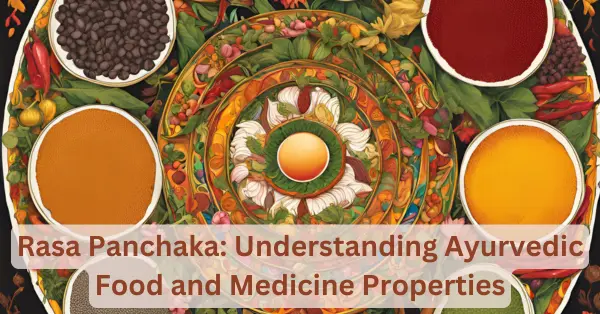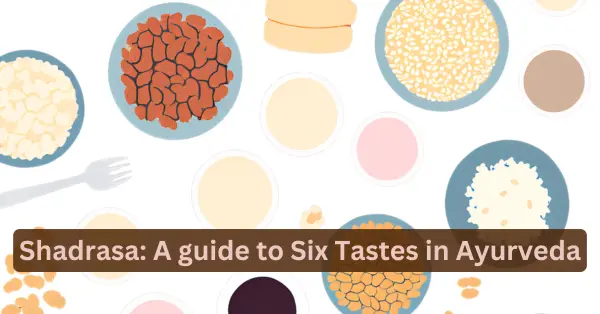In this article, we will comprehensively cover the topic of virudha ahara or incompatible food combinations in Ayurveda.
Introduction
Having a seven-course meal sounds romantic and mouth-watering. Was every dish compatible in that seven-course meal? There is a concept in Ayurveda known as food compatibility. One food may not be compatible with another food.
Virudha Ahara, or incompatible food combinations, is a concept in Ayurveda to prevent diseases and imbalances in the body.
Why shouldn’t we consume Incompatible food combinations?
Ayurveda says that every food has a taste (Rasa), effect (Virya), post-digestive effects (Vipaka), and effects on bio-energy or doshas. We determine whether a combination is correct or incorrect based on these food factors.
When wrong food combinations are eaten together, they can imbalance the doshas, disrupt digestion, and therefore cause toxins to form in the body. The digestive fire called “Agni” can become imbalanced, causing many ailments.
In other words, if you eat incompatible food combinations, your digestive fire will weaken, and fermentation in the digestive tract will occur. This will lead to severe acidity or Ama formation. As a result, slowly but gradually, diseases will occur.
This also doesn’t mean you turn yourself over-anxious about wrong food combinations. A tiny amount of wrong food combinations can be forgiven. It takes months and years of eating bad food combinations to get something fatal.
Signs of incompatible food combinations consumption
Common symptoms after consuming bad food combinations in the body are given below, with the research-backed evidence.
- Bloating and Gas. The adverse effects of improper food combinations are not confined to the gastrointestinal tract alone; they may also impact other vital systems of the body.[1]
- Vomiting or Nausea
- Sluggishness
- Fatigue
- Skin allergies
- Bad breath
- Bad body odour
- Digestive issues. Avoiding virudha ahara promotes digestion and overall health.[2]
- Neurological disorders. This may result in various health issues, including neurological disorders, often without people being aware of the connection.[3]
Avoiding the intake of incompatible foods plays an important role in the prevention of dermatological disorders.[4] Teenagers should especially take care of this as they are prone to acne.
Let’s understand this from deep Ayurvedic concepts.
Wrong food combinations imbalance the three doshas in the body.
Vata Imbalance– If you have a Vata imbalance in the system due to a bad food combination. You are likely to suffer from bloating, gas, anxiety, and constipation.
Cold, dry, and light foods increase the vata. If you combine these foods with similar qualities, you will have a vata aggravation.
Pitta Imbalance– Pitta increases with the consumption of hot, sour, and spicy foods. Combination with similar foods will lead to acidity, heartburn, skin rashes, and irritability.
Kapha Imbalance– Heavy, Sweet, and extra-oily foods can aggravate the Kapha dosha. Combination with foods with the same qualities will lead to congestion, poor digestion, lethargy, and unhealthy weight gain.
Wrong Food Combination List
Given below is the wrong food combination list (images) according to Ayurveda.
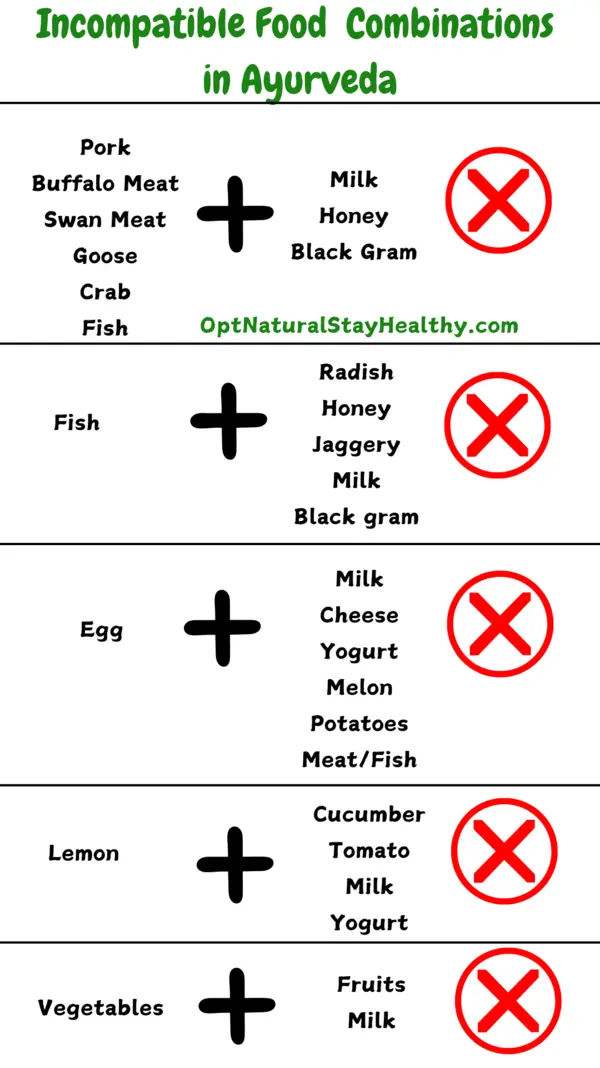
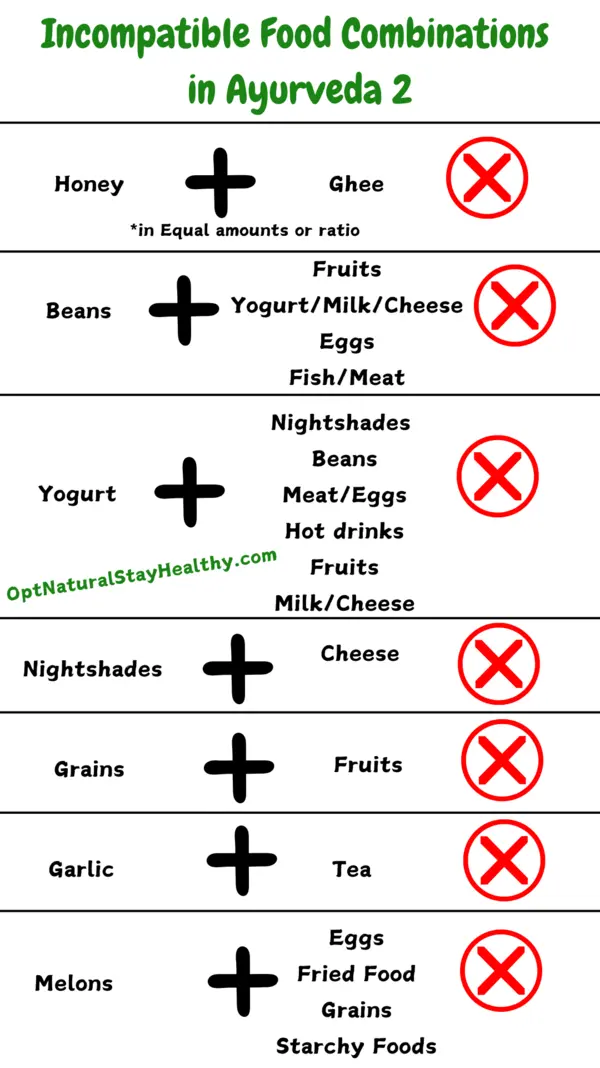
Milk Compatibility in Ayurveda
Milk is an important source of protein in a vegetarian diet. One must learn how to combine or not combine milk with other foods.
Understanding the importance of proper food combinations—such as refraining from mixing milk with sour items or combining dairy with certain proteins—can help individuals support better digestion and improve overall health.[5]
Foods compatible with milk
1. Turmeric
2. Ripe Mango
3. Barley
4. Ghee, honey, and sugar
5. Dry Ginger, cinnamon, and black pepper.
Incompatible food combinations with milk
1. Banana (people with an exceptional digestive strength can have it in small quantities)
2. Radish
3. Leafy
4. Cherries
5. Meat
6. Fish
7. Melons
8. Citrus Fruits (denature the protein in the milk)
9. Oily, salty food
10. Khichdi
11. Jackfruits
Honey and Ghee in equal amounts
It’s a BIG NO.
Honey has the property of heat, and Ghee has the property of cold. Ayurveda suggests that one should never combine the opposite properties in equal amounts.
A combination of Ghee and Honey in equal amounts causes the accumulation of free radicals in the body. As a result, it can lead to ulcers and eventually cancer.
It acts as a slow poison.
However, you can consume ghee and honey in unequal amounts. (Honey2):(1Ghee) is beneficial for Kapha Dosha and (Honey1):(2Ghee) is useful for Pitta and Vata Dosha.
The scientific reason why Honey and Ghee in equal amounts are poisonous
Honey is a complex polysaccharide that requires special enzymes to break it down to use as simple sugars. On the other hand, Ghee is a complex chain of fatty acids that requires emulsification and the action of lipases and lipid-breaking enzymes.
When these enzymes interact with one another in our gastrointestinal tract, it leads to indigestion and the formation of Ama (acid) and causes the accumulation of free radicals. These free radicals are the cause of many diseases.
A research study was conducted on 24 rats, where a mixture of equal amounts of honey and ghee was given to the rats. After 60 days, symptoms such as unexplained weight loss, hair thinning, reddish discolouration on the ears, and elevated liver enzyme levels were observed in the rats.
The findings suggest that the elevated production of Amadori compounds, enhanced DPP-4 enzyme activity, and reduced levels of incretins (GLP-1 and GIP) may jointly contribute to heightened post-meal blood sugar levels, which in turn could lead to oxidative stress-induced toxicity when honey and ghee are consumed in equal proportions.[6]
Minimise the effects of wrong food combinations
You have consumed the wrong food combinations, and now you are suffering from the symptoms.
There are ways to minimise the impact of bad food combinations. The basic idea is to increase the digestive fire somehow. The ways are as follows-
1. Stimulate Agni
Chew a slice of ginger with a pinch of salt, half an hour before meals, to stimulate agni or the digestive fire.
2. Include Ghee in your diet
Ghee stimulates the Agni or digestive fire. You must have at least 2 teaspoonfuls of ghee in your meals daily.
3. Quantity matters
Take the wrong food combinations in small quantities to minimise their effects.
4. Warm Water
Sip a small quantity of warm water along with the meal. It increases the digestive fire.
5. Ayurvedic Tea after meals
Take tea according to your predominant Dosha. Vata, Pitta, or Kapha Tea. You can have the tea half an hour after the meal.
Table Guide for Incompatible Foods
| Food Item | Should Not Be Combined With |
|---|---|
| Milk | Banana, melon, sour fruits, fish, yogurt, meat, yeast bread |
| Yogurt | Sour fruits, hot drinks, fish, meat, mango, cheese, milk, nightshades |
| Fruits | Other foods (best eaten alone, except dates with milk) |
| Melon | Any other food, especially dairy, grains, starches |
| Honey | Ghee in equal amounts by weight, cooked or heated honey |
| Lemon | Fruits (especially melon), beans, cheese, fish, milk, meat, yoghurt |
| Eggs | Fruit, cheese, eggs, fish, milk, meat, yoghurt |
| Beans | Mango, cheese, fish, meat, starch, yoghurt |
| Grains | Fruit, tapioca |
| Hot Drinks | Melon, cucumber, and dairy products |
| Nightshades | Melon, cucumber, dairy products |
| Radish | Banana, raisins, milk |
| Tapioca | Banana, melon, sour fruits, fish, yoghurt, meat, yeast bread |
The best time to eat fruits
Ayurveda recommends the ideal time for each fruit to be consumed in a day. However, an organic fruit is fit to consume at any time of the day. There is an ideal time for everything for maximum benefits.
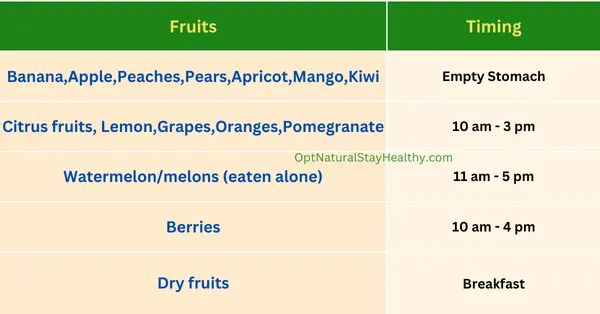
Conclusion
Avoiding incompatible food combinations is a holistic approach toward health. It is crucial to prevent the formation of toxins in the body and maintain the natural equilibrium of the body.
Scientific studies have shown that incompatible food combinations can impair digestion, hinder iron absorption, and promote the accumulation of toxins in the body, potentially leading to symptoms similar to anaemia.[7]
It would be much easier to maintain a healthy and robust body once you are aware of food combinations and your body type. You must apply the knowledge of Ayurveda practically to see the results.
Reference
[1] Mishra DM, Kapgate SM. Understanding Of Concept Of Viruddhahara (Incompatible Food) In The Light Of Conventional Science. Journal of Advanced Zoology [Internet]. 2024 Sep 17 [cited 2025 Jun 27];45(1):730–6. Available from: Link to Study. <Go to Citation>
[2] Vidyadhar Balikai. Conceptual study of Viruddha Ahara in Ayurveda along with Modern perspective. Journal of Ayurveda and Integrated Medical Sciences. 2025 Feb 27;9(12):210–4. Available from: Link to Study. <Go to Citation>
[3] Ansari A, None Ghanashyam H. Kodwani. Role of incompatible food and regimen in neurological disorders. Journal of ayurveda and integrated medical sciences. 2023 Dec 9;8(10):153–9. Available from: Link Study. <Go to Citation>
[4] Sahu DA, Dr. S. R. Inchulkar, Kaushik DY, Sharma DK. Role of Viruddha Ahara in dermatological disorders and its prevention. Journal of Ayurveda and Integrated Medical Sciences [Internet]. 2025 Jun 10 [cited 2025 Jun 27];5(05):472–6. Available from: Link to Study. <Go to Citation>
[5] Dr. Shankar Lal Jat, Dr. Ashok Yadav, Dr. Om Prakash Nain, Dr. Virendra Singh, Dr. Praveen Kumar. The Concept of Viruddha Ahara – A Systemic Review. AJBR [Internet]. 2024 Oct. 24 [cited 2025 Jun. 27];27(3S):6647-9. Available from: Link to Study. <Go to Citation>
[6] Toxicity profile of honey and ghee, when taken together in an equal ratio. Toxicology Reports [Internet]. 2020 Jan 1 [cited 2021 Apr 13];7:624–36. Available from: Link to study. <Go to Citation>
[7] Arpita Das, Aradhana Kande, Nikhila Ranjan Nayak. A Review Article on the Impact of Viruddha Ahara Vihaar on Pandu w.s.r, to Dietary and Lifestyle Factors. J Ayurveda Integr Med Sci [Internet]. 2025Apr.30 [cited 2025Jun.27];10(3):130 -139. Available from: Link to Study. <Go to Citation>

